Sure, we’ve seen movies with stereotypical Japanese references, but what makes Japan unique? Keep reading because we’ll dig deep into the 25 “things that make Japan, Japan.”
Japan offers its visitors a one-of-a-kind culture and personality found nowhere else in the world. A trip to Japan is undoubtedly an unforgettable experience for anyone, and many visitors find themselves returning again and again to celebrate this beautiful, charming country.
Many things make Japan unique from every other country, from the people to the stunning architecture, bright culture, and delectable cuisine. Japan is a truly special place.
Here are just 25 reasons why visiting Japan is uniquely, well… Japanese. And why Japan is a special place, unlike any other in the world. After reading this list, you will get a sneak peek into why Japan is worth every minute of your time to experience.
1. Japan Has 25 UNESCO World Heritage Sites
For all the history buffs and celebrators of all things culturally amazing, Japan has twenty-five UNESCO World Heritage sites for you to explore, 20 cultural sites, and five natural sites.
A World Heritage site is designated by UNESCO for having cultural, historical, scientific, or other forms of significance. The sites are judged to contain “cultural and natural heritage around the world considered to be of outstanding value to humanity”.
Fun fact: seventeen of Japan’s twenty-five UNESCO World Heritage sites are found in or near the city of Kyoto. Kyoto is considered the cultural heart of Japan, and its historical sites date back to the 10th through the 19th centuries. Thirteen Buddhist temples, three Shinto shrines, and one castle can be found in, or just outside, Kyoto.
2. Kyoto
It seems only fitting to talk about Kyoto as the second most unique thing about Japan. Kyoto is the historical and cultural heartbeat of Japan.
Kyoto is the best Japanese place to visit to experience traditional festivals, gardens, temples, geisha, and of course, more temples.
The former imperial capital of Japan, Kyoto is famous for:
- Peaceful sites like the Arashiyama Bamboo Grove and my personal favorite, the Fushimi-Inari shrine and its majestic path lined with torii gates… Both are perfect for those epic Insta shots!
- Historic structures like Kinkaku-ji Temple and Nijo Castle
- Old wooden houses and tea rooms in the Gion district
- You might even spot a geisha and their maiko apprentices out and about
If you’d like to learn more about Kyoto and what makes it so special, please check out my post here.
Interesting fact about Kyoto: in World War II, the allies avoided bombing Kyoto because of its unique cultural and historical history, so it looks untouched by time.
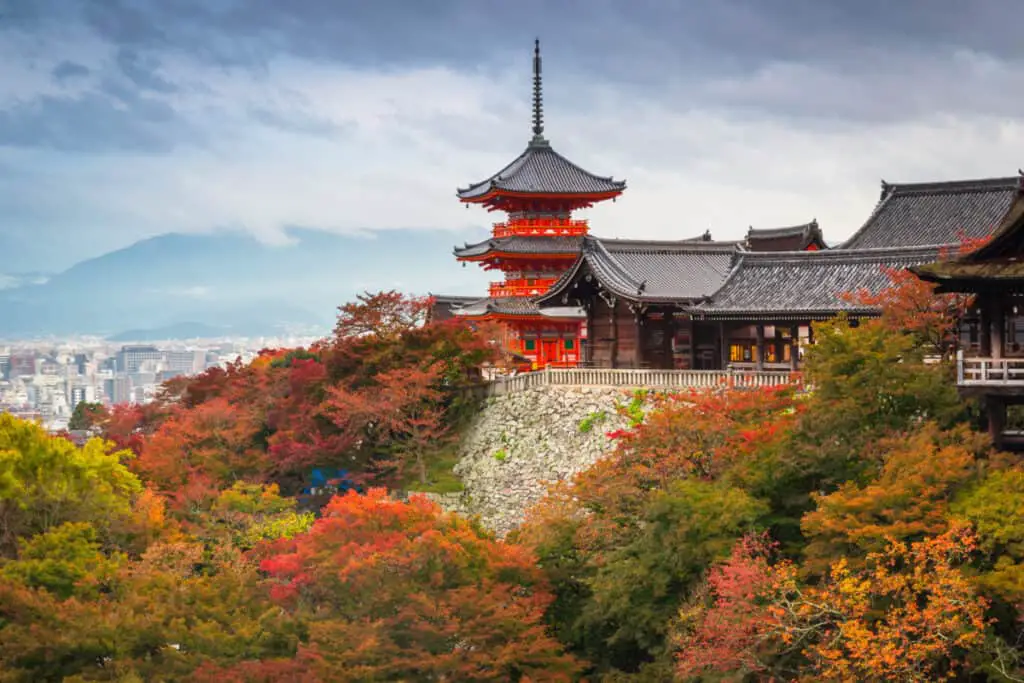
3. Low Crime Rate
Japan is one of the safest countries globally, and it is considered the safest country in Asia. Here are some Japanese crime (or lack thereof) statistics:
- The safest country globally
- 2nd lowest homicide rate (Iceland)
- 2nd lowest assault rate (blame Canada)
- Only 1.4% of the population have been victims of assault or muggings
Law enforcement efficiency and an overall cultural responsibility are the reasons for this low crime rate. Police officers get more extended professional training, the Japanese court system is efficient, and there is a strict ban on handguns in Japan. Police officers generally take great pride in their duties and respect the position.
While I certainly would not recommend it, I have on occasion left my passport and wallet on the bar in a club while I went to visit the men’s room only to find it in exactly the same place I left it. Talk about complacency!
It’s common in Japan to see Macbooks used to keep seats even in the busiest of cafes. The most famous example of those is the Starbucks by Shibuya Crossing. Again, I wouldn’t recommend leaving any valuable or important items hanging around unsupervised, even in Japan!
4. Japan Has Over 1500 Earthquakes Every Year
Japan reports more earthquakes each year than any other country in the world, and Japan experiences dozens of earthquakes each month.
Japan’s location along the Pacific “Ring of Fire” and its location positioned directly over three tectonic plates is to blame for the frequency of earthquakes.
The frequency of seismic activity gives Japan the densest seismic network globally. There is a chance you’ll experience one of these earthquakes while you’re visiting.
While experiencing an earthquake is something that most people avoid, most of these tremors are too small to feel, and the ones that are felt are barely noticeable.
In all of the time I’ve spent in Japan, I haven’t felt too many. A notable exception is the one that happened during a typhoon in October 2019, the rugby world cup year. Talk about timing!
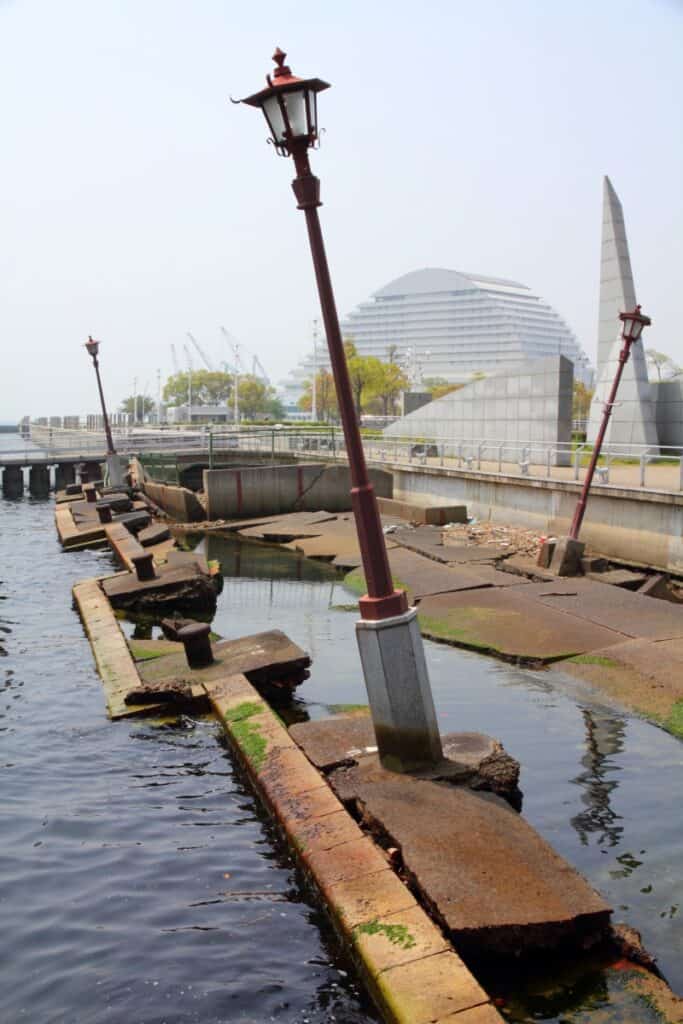
5. Japan Has the Best Customer Service in the World
If you are a fan of fantastic customer service (and honestly, who isn’t?), Japan will make your heart happy.
Japan sets the global standard for excellent customer service. Their culture seems to have instilled an understanding that excellent customer service is just part of doing a job correctly.
They aren’t making you happy so that you leave a good tip. In fact, tipping is something that is frowned upon in Japan. They are making you happy because that is what their job entails.
And Japan’s top-notch customer service isn’t something you’ll find only at 5-star hotels and leisure resorts. You can even expect people-pleasing clerks and servers at convenience stores, fast food places, and restaurants. As a British person, it’s almost like a little slice of heaven! It’s very rare to get good customer service outside of expensive establishments in the UK!
6. Mount Fuji
Mount Fuji (and its iconic image) is a breathtakingly beautiful sight that makes Japan unique and the name speaks for itself.
This icon of Japan stands at 12,388ft, or 1.34 miles, tall. Mount Fuji is actually an active stratovolcano that last erupted in 1707 and is a popular hiking spot.
Fuji is a must-see for any visitor to Japan. And the odds are good that you have its image ingrained in your brain before you even see it… However, the old cliche rings true. You have to see it with your own eyes to really appreciate it!
If you want an idea of what to expect when climbing Mt Fuji check out my post here!
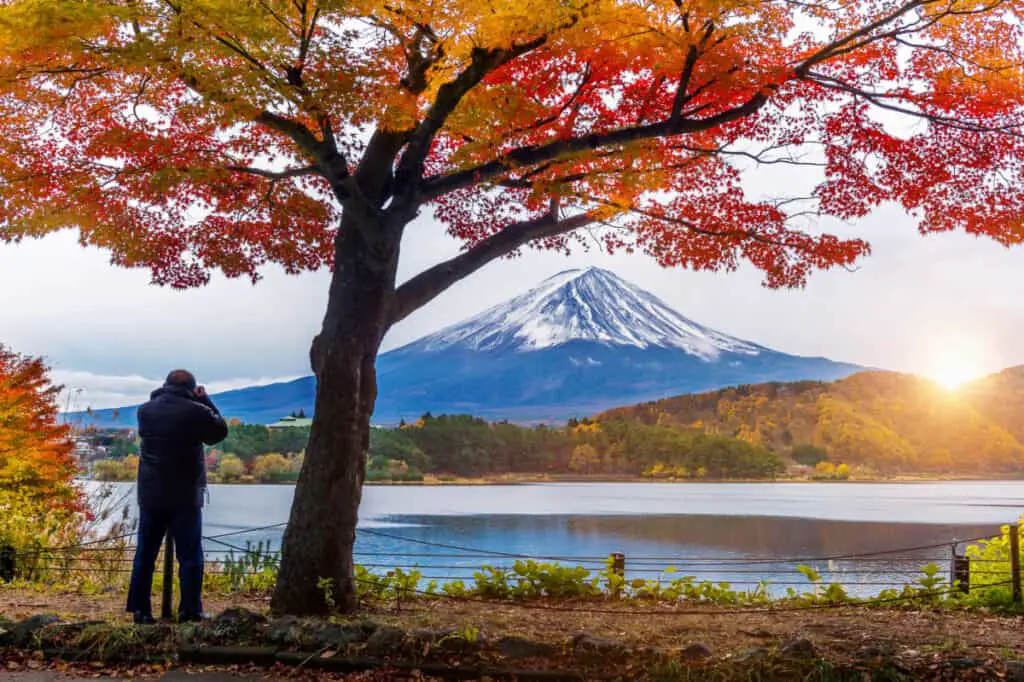
7. Sumo Wrestling
Sumo is a form of wrestling that goes back to the earliest historical records in Japanese history.
Sumo has become a professional sport and is extremely popular all across Japan. Arenas for sumo are standard nationwide and the sport often appears on TV.
Since sumo is native to Japan, it can be described as the national sport. More so than baseball, and the Japanese love baseball. #Ichiro #ShoheiOhtani
Sumo combines some of the most public forms of Shinto (see #13 below) rituals with ~600 lb. slamming into each other.
In case you’re unaware of sumo rules:
- There are two wrestlers
- A winner is crowned when:
- One wrestler is forced out of the wrestling ring, or
- Anything (other than his feet) touches the playing surface
8. Washoku, aka Japanese Cuisine
Japanese cuisine, or Washoku, is a delicious reason in itself to visit Japan. Japan’s flavors and restaurants make eating your way through it a unique and rewarding experience.
Japan has 668 Michelin-starred restaurants. Twenty-nine restaurants have 3 Michelin stars, while 124 restaurants have 2 Michelin stars. It is said that these successful restaurants excel because Japanese culture promotes perfectionism. Japanese chefs take their craft extremely seriously and have accolades to prove it.
In fact, UNESCO added traditional Japanese food (Washoku) to its Intangible Cultural Heritage list.
Adding food to a cultural heritage list is not unheard of to stop traditional dietary habits from dying out in a country.
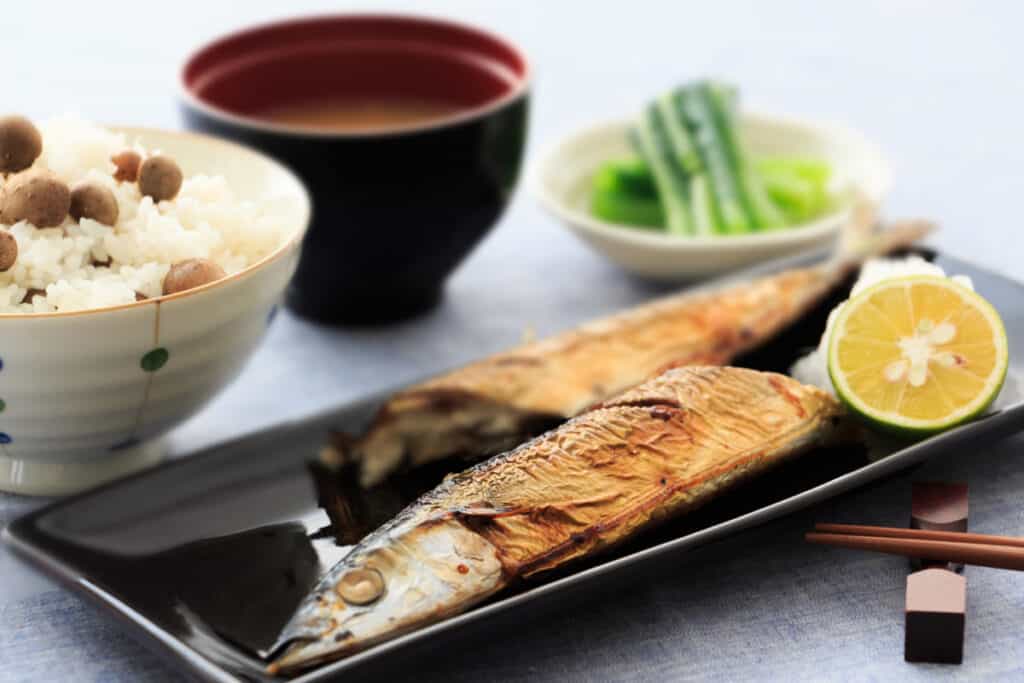
9. Kimonos
The kimono is a significant symbol of Japanese heritage. These robes are worn wrapped left side over the right and secured with a sash called an ‘obi’.
The wrap style allows for easy movement, which is vital in a culture where many activities are performed seated on the floor.
Kimonos are unique to Japan, and one thing that sets them apart from other cultures. Today, many locals wear these traditional garments for special occasions, such as weddings, festivals, and graduations.
There are a few places you can rent kimono for a day and get a unique experience strutting around Kyoto like it’s 1679 (don’t hate me, I can’t think of a cool year!). It’s a beautiful sight seeing the streets of Kyoto in summer with the kimono in full bloom!
Follow this link for a great spot to rent kimono for both women and men. They have so many options available and professionals to help with dressing and hair styling etc. The process is fairly straightforward and Okamoto have been welcoming tourists for years!
10. Kawaii Culture
No other country on Earth appreciates cuteness as much as Japan does. From adorable mascots, cartoons, and warning signs to pop culture icons and advertisements, kawaiiness is one of the most prized attributes a thing can have in Japan.
“Kawaii” means lovely, cute, and adorable in Japanese, so Kawaii refers to:
- Items
- Humans
- Non-humans
…that are:
- Charming
- Shy
- Childlike
Kawaii is popular in Japan because Japanese culture values youth, and men and women seek to emulate youth by adopting the kawaii style of dress and lifestyle.
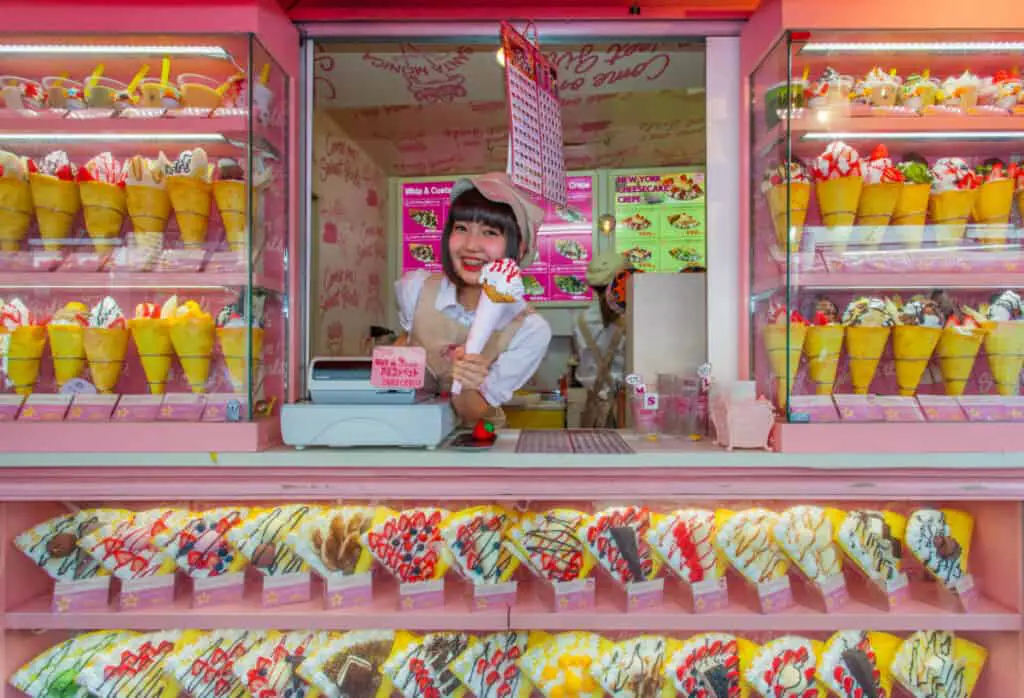
11. No Shoes Allowed Inside Homes
Traditionally (and still quite often), it is considered rude to wear shoes inside the house. Some restaurants in Japan even require guests to remove their shoes. If you see tatami floors in a restaurant and you still have your shoes on, you will be testing every ounce of the restaurant staff’s patience (much like I did on my first ever visit to Japan. The look on the poor guy’s face was priceless though, sorry!) This is a very old tradition in Japan that goes back centuries.
This tradition of taking off shoes began for cleanliness reasons since the Japanese ate meals sitting on tatami mats instead of chairs and slept on roll-out futons on the floor.
Since both activities are very close to the floor, keeping the floors as clean as possible was important. So no shoes were allowed. Even today, many locals require guests to remove their shoes before entering a home.
Most Japanese people are aware that not all foreigners are used to cultural differences and they’ll usually help you by pointing out places to take them off like the genkan at the entrance. If you notice a step up into the house/building immediately after the entrance, I recommend playing it safe and taking your shoes off on the lower level before entering.
12. Over 80% of Japan is Mountainous
Did you know that Japan is home to around 10% of all active volcanoes?
It’s true!
There are currently 100 active volcanoes in Japan.
Fear-mongering aside, mountainous Japan offers excellent skiing and hiking. Japan has dozens of national parks featuring mountain landscapes.
The Hida Mountains, also known as the Japanese Alps contain some of the highest peaks in the country. The mountains of Hotaka and Yari are both over 10,000 ft. tall. The Japanese Alps attract snow bunnies and mountain lovers from all over each year.
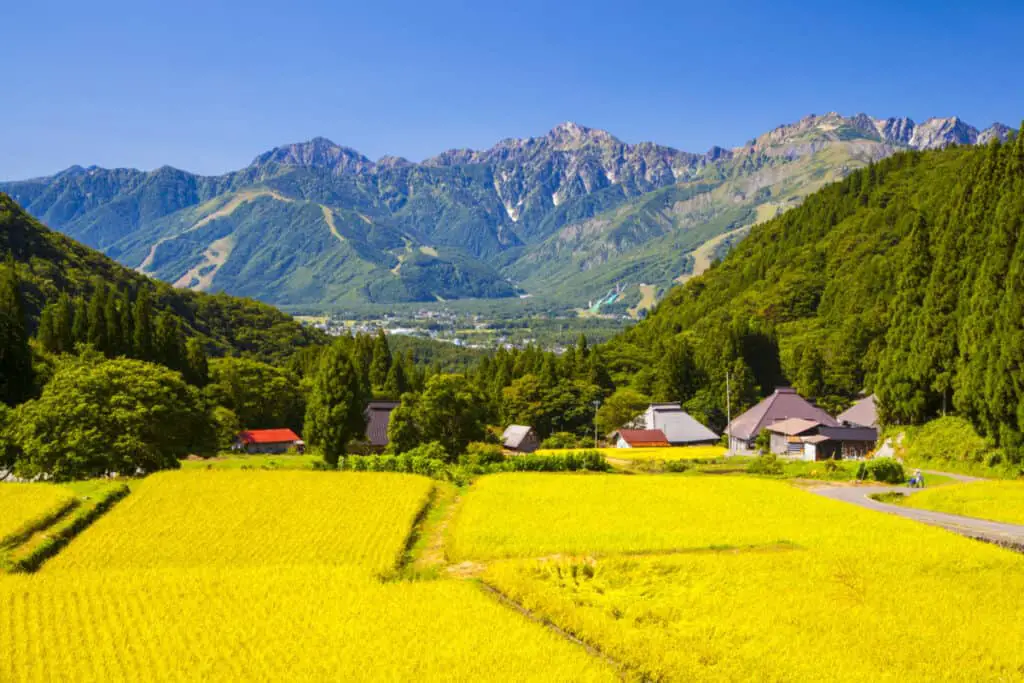
13. Japan is Home to Shinto
Shinto is widely considered to be the native religion, or belief system, of Japan. The many Shinto practices and traditions revolve around land and seasons in relation to humans.
Shinto means “the way of the gods” in Japanese, and many Shinto traditions and festivals play a significant role in everyday life.
The central beliefs of Shinto are the importance of:
- Purity
- Harmony
- Respect of nature
- Respect of family
- Subordination of the individual in respect of the group
There are many Shinto gods and spirits, known as “kami,” and each has shrines dedicated to them where people leave offerings. In Kyoto alone, there are over 400 Shinto shrines.
14. Cherry Blossoms
The Cherry blossom is the unofficial national flower of Japan. These stunning trees bloom for several weeks, starting around March and April.
Sakura, which they are called in Japan, are trees with beautiful pink flowers known for their delicate appearance and sweet scent. The cherry blossom tree is a quintessential Japanese image, and there are over 300 types.
People travel to Japan just to experience cherry blossom blooms each Spring. Yoshino, Kansai is the most famous cherry blossom destination in Japan. Here, over 30,000 cherry blossom trees cover the Kii Mountains that surround the town during the Spring. The cherry blossom flowers and leaves are edible and are used in traditional Japanese teas and desserts.
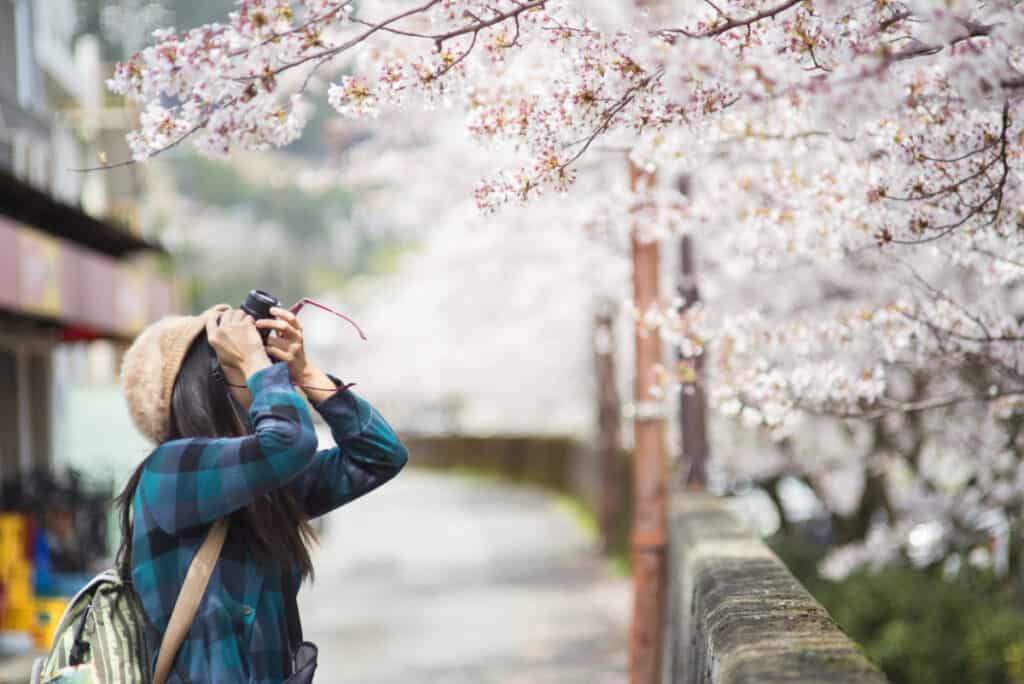
15. Bullet Trains
Japan is home to a high-tech, high-speed railway system. The Shinkansen is a railway network operated by Japan Railways that offers nine lines that connect the major cities of Japan.
These sleekly designed bullet trains carry passengers all over the country, running up to 198 mph.
These extremely punctual, clean, and dependable bullet trains are the fastest and most comfortable way to travel long-distance throughout Japan. Their efficiency and speed are impressive at moving people all over the country quickly. They are a unique and impressive experience.
Being from the UK, my first time on a bullet train was mind-blowing. Watching the outside world rip by the window while your food and drink stay perfectly still on the fold-down plastic tray has to be the work of some kind of sorcery. I still can’t believe it’s real!
Bullet trains are one of the easiest ways to get around Japan and I always use them whenever I plan to travel long distances simply because of how convenient they are.
While bullet trains are relatively expensive to use for a long-term resident of Japan, as a traveler you’re eligible to buy a Japan Rail Pass. With a JR Pass, you can use almost every JR train in Japan an unlimited amount of times within the period your pass is valid for. (The pass isn’t valid on Nozomi or Mizuho trains).
I always did this and recommend getting a JR Pass to anyone who wants to see more than one region as it’s a great option to save time and money… All while getting to enjoy some amazing views of Japan that aren’t really possible any other way.
To check out the current prices, save some money, and remove the guesswork involved with booking train tickets in Japan, follow this link to the JR Pass website.
16. Tokyo
Tokyo is an unforgettable and highly unique experience all on its own. Tokyo is the biggest metropolis in Japan, and no other city in Japan captures the mix of tradition and modernity better than Tokyo.
Tokyo is famous for being a city of the future, with Akihabara (“Electric Town”), robot restaurants, and bullet trains. Tokyo is also home to many old cultural landmarks and architecture.
Tokyo has more Michelin-starred restaurants than any other city, making it home to a fantastic culinary scene. There are more than 226 Michelin-starred restaurants in Tokyo, eleven of them receiving a three-star rating.
It’s not only the fine dining side of it that Tokyo does well. There are tons of amazing hole-in-the-wall restaurants, plus standing bars and eateries down alleyways where you’d never dream of setting up shop in a Western country. Shinjuku Golden Gai is a truly unique experience in and of itself and well worth exploring in the evening. You might even spot some celebrities grabbing a quick bite and a few drinks!
Tokyo is famous for the latest Japanese fashion trends, iconic monuments and statues, skyscrapers and neon futuristic cityscapes, and its futuristic tech havens like Odaiba and Akihabara.
Are you familiar with the world’s busiest intersection? Well if you hate traffic, don’t go see Shibuya Crossing, the busiest crosswalk in the world. Seriously, if you thought New York was bad, how do you feel about 3,000 people crossing a crosswalk at the same time?!
Mixed in with this bustling high-tech cityscape are plenty of peaceful Japanese gardens and parks. There are shrines and temples throughout the city as well. Tokyo really is a mix of the old and the new and is a must-see.
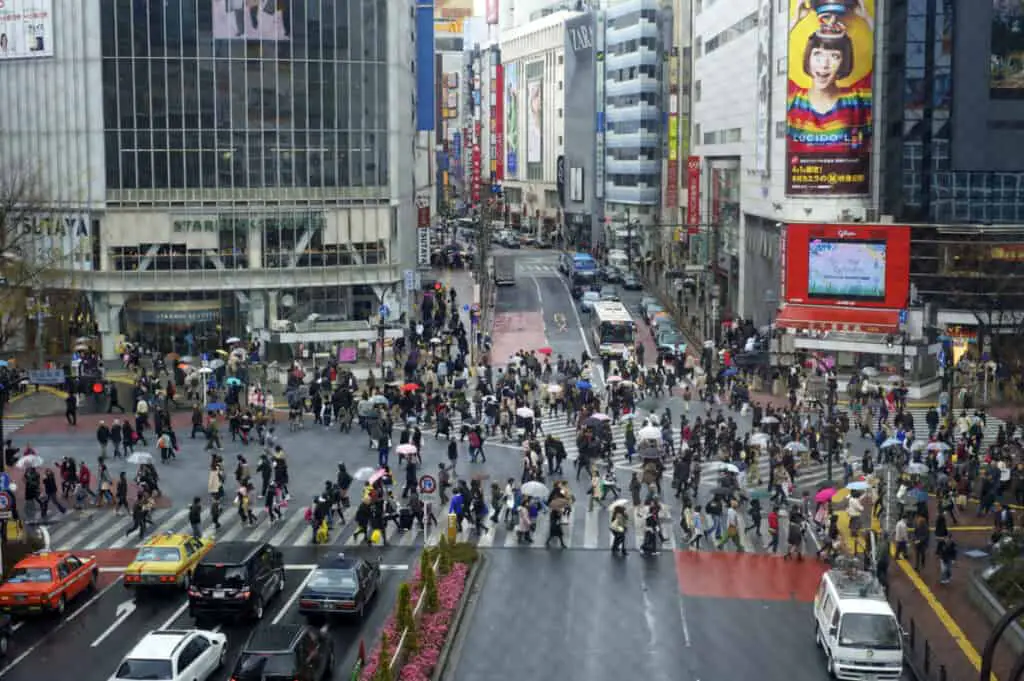
17. Green Tea
If you are a green tea lover, then Japan is a must-visit.
Japan is known for its tea-loving and drinking culture, especially when it comes to green tea, or matcha, as they call it. Green tea is the most popular type of tea in Japan and is rich in antioxidants.
Matcha is high in catechin (a phytochemical) called epigallocatechin gallate (EGCG), which is a cancer-fighter.
Studies have linked green tea to many health benefits, like:
- Preventing heart disease
- Preventing type 2 diabetes
- Preventing cancer
- Promoting weight loss
Maybe this is why the Japanese have one of the longest life expectancies on Earth?
A Japanese tea ceremony is a cultural activity involving the ceremonial preparation and presentation of matcha (powdered green tea), the art of which is called temae to guests. Zen Buddhism was a primary influence in developing the Japanese tea ceremony and is still practiced in Japan.
18. Japan Created Karaoke
If you love karaoke, you have Japan to thank because they pioneered the scene!
The karaoke machine was invented in the 1970s as a way for people to sing at the club without live backup singers.
“Kara” means “empty” in Japanese and “oke” is the shortened version of “okesutora” which means “orchestra.” So together, it means “empty orchestra” which perfectly describes the act of singing along with an instrumental version of a song on a screen.
Not only did Japan create karaoke, but they enjoy karaoke as a social event. There are many karaoke bars and clubs throughout Japan featuring karaoke.
Some of my best memories are from nights in karaoke with my friends. It’s the perfect way to start a night out! If you go to a chain like Big Echo, you can book a private booth with “tabehoudai”, all you can eat, and “nomihoudai”, all you can drink. When you get in the room there are usually two tablets, one for selecting the songs and the other for ordering food and drink which gets delivered to your room.
There’s nothing better than cheap karaage and ice-cold beer with your friends in the summer!
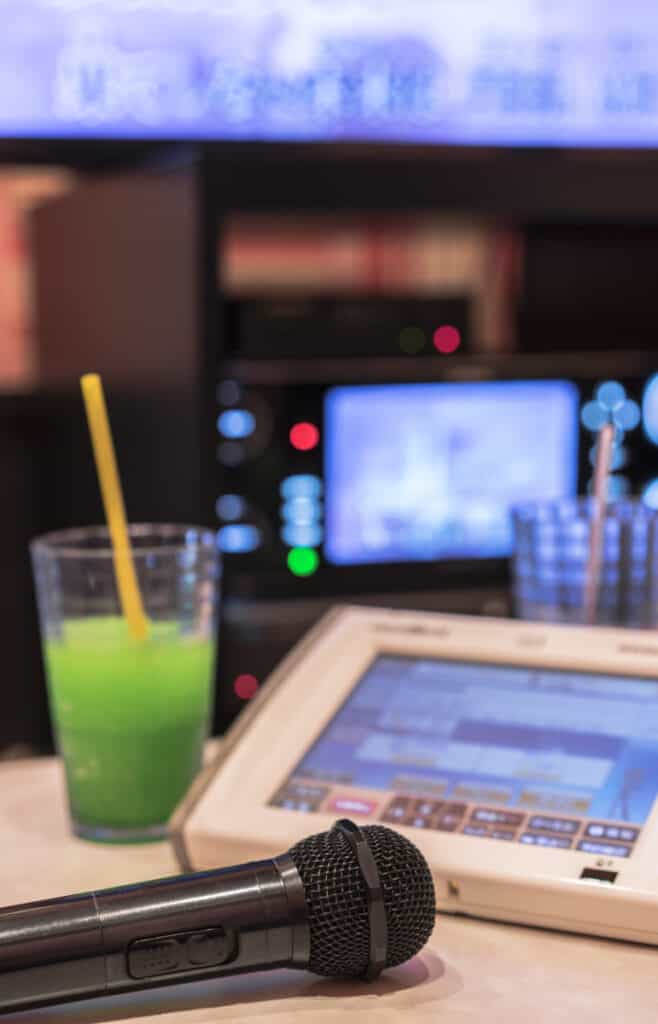
19. Anime and Manga
Anime is one of Japan’s most iconic exports, and while it may look like just a cartoon,believe it or not, it is quite different. Anime has visually distinct features for characters and a more limited animation style for depicting movements.
The word “anime” is an abbreviation of “animation.” In Japan, “anime” refers to all animation, while everywhere else in the world, “anime” refers specifically to animation from Japan. People who like anime often also enjoy Japanese comic books, known as manga.
Anime uses classical animation production through storyboarding, character design, and voice acting. If you don’t know much about anime (like I didn’t), the artists don’t re-draw each frame. Instead, they only re-draw the dynamic parts and leave the static things (like backgrounds). It means no need to illustrate an entirely new scene every time, and that practice gives anime its district, recognizable features.
20. Samurai
Japan is home to the legendary samurai warriors.
What are samurai? Samurai were an elite class of Japanese warriors who performed military service for nobles. They were well-trained and highly skilled at riding horses and using the bow and sword. They wore particular armor and followed a code of honor known as bushido while performing their duties.
Samurai originated during the Heian Period (794-1185) when Japan was divided into independent kingdoms that often fought each other.
The feudal lords of these kingdoms would train warriors to protect their territories. These warriors were legendary for their courage and skills on the battlefield. Samurai is still an active part of Japanese pop culture and inspires movies and anime.
21. There is a Vending Machine For Everything
Japan has a vending machine for pretty much anything you can think of. You can find your usual munchies and snacks, but you can also find:
- Live rhinoceros beetles
- Umbrellas
- Bread in a can
- Bugs in a chip bag
- Microwaved meat
- Neckties
Seriously! There are roughly 5+ million vending machines scattered throughout the country, and their sight is uniquely Japanese.
Every time I land in Japan, the first thing I do is find a vending machine to get some Pocari Sweat. It’s not like a love story or anything…

22. Capsule Hotels
Japan is famous for capsule hotels, also known as pod hotels, a unique lodging style that caters to budget travelers. This type of hotel was created in Japan in 1979 and featured many small bed-sized rooms known as capsules.
The capsules range in cost from $19 per night to $47 per night. They have just enough room for a single futon mattress and one person. Toilets and showers are communal. However, these hotels are not for those with claustrophobia issues.
Capsule hotels are uniquely Japanese and are very common throughout the country.
I’d recommend trying one to experience it but only for one night (unless you’re desperate or you’re on a tighter budget!).
23. Japanese Architecture
Japanese architecture has a particular look. Traditional architecture often includes curved roofs and hidden roofs. These roofs are commonly used in Japanese Buddhist temples and shrines.
But why curved roofs?
Because curved roofs ward off evil spirits, of course! Once upon a time (maybe they still do?), Japanese people thought that evil spirits hated curves because they would fall off the roofs due to the angles.
Visually, this type of roof consists of a top roof and a bottom (hidden) roof. Japanese construction used a combination of wooden pillars and beams to protect the structures during earthquakes.
Traditional Japanese houses are called minka and have an easily identifiable look. These houses include tatami flooring, sliding doors, and wooden verandas circling the home.
24. Bamboo Groves
Japan has the most famous bamboo grove in the entire world. The Arashiyama Bamboo Grove is just under 10 miles of beautiful soaring stalks of bamboo and is considered part of the “soundscape” of Japan.
Walking through this park, just outside of Kyoto, is like being in another world. The sounds made by the wind through the bamboo are like no other, so add a bamboo grove to your Japanese itinerary.
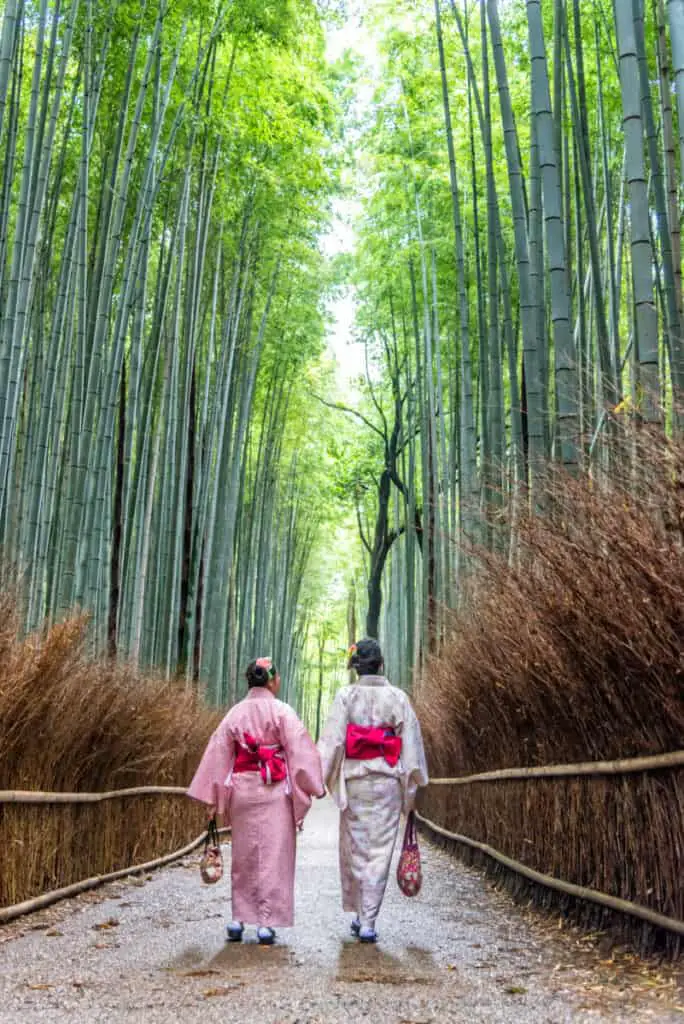
25. Bowing
In Japanese culture, bowing is a sign of respect. The Japanese learn how and when to bow from a young age and use bowing often.
Bowing can mean anything from “Thank You” to “I’m Sorry”. Bowing is used to show emotions and can vary from a small nod of the head to a deep bend at the waist. A long bow indicates respect, while a slight nod is less formal.
Seriously though, bowing is a massive part of Japanese culture. As a general rule, people will bow when they meet you, when they’re serving you in a conbini (convenience store), if you accidentally make eye contact in the street, and even while you’re boring them to death with your awkward beginner level Japanese… Okay, that last one is just me.
It’s even more noticeable when I’ve spent time with my Japanese friends visiting Europe because they always appear super polite which makes me look (extra) rude in comparison!
Recap: What Makes Japan Unique?
Japan is an incredibly unique cultural experience. Japanese culture and principles have stood the test of time. From ancient Shinto traditions and temples to their love and appreciation of nature, to their unique architecture, beautiful landscapes, and technological advancement, Japan is an amazingly unique country.
The people of Japan are respectful, and courteous and take great pride in their culture. They are said to be the friendliest society in the world. Japan operates very efficiently as well and is a very traveler-friendly country to visit.

